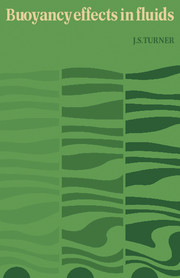Book contents
- Frontmatter
- Contents
- Preface
- 1 INTRODUCTION AND PRELIMINARIES
- 2 LINEAR INTERNAL WAVES
- 3 FINITE AMPLITUDE MOTIONS IN STABLY STRATIFIED FLUIDS
- 4 INSTABILITY AND THE PRODUCTION OF TURBULENCE
- 5 TURBULENT SHEAR FLOWS IN A STRATIFIED FLUID
- 6 BUOYANT CONVECTION FROM ISOLATED SOURCES
- 7 CONVECTION FROM HEATED SURFACES
- 8 DOUBLE-DIFFUSIVE CONVECTION
- 9 MIXING ACROSS DENSITY INTERFACES
- 10 INTERNAL MIXING PROCESSES
- Bibliography and Author Index
- Recent Publications
- Subject Index
- Plate section
2 - LINEAR INTERNAL WAVES
Published online by Cambridge University Press: 05 August 2012
- Frontmatter
- Contents
- Preface
- 1 INTRODUCTION AND PRELIMINARIES
- 2 LINEAR INTERNAL WAVES
- 3 FINITE AMPLITUDE MOTIONS IN STABLY STRATIFIED FLUIDS
- 4 INSTABILITY AND THE PRODUCTION OF TURBULENCE
- 5 TURBULENT SHEAR FLOWS IN A STRATIFIED FLUID
- 6 BUOYANT CONVECTION FROM ISOLATED SOURCES
- 7 CONVECTION FROM HEATED SURFACES
- 8 DOUBLE-DIFFUSIVE CONVECTION
- 9 MIXING ACROSS DENSITY INTERFACES
- 10 INTERNAL MIXING PROCESSES
- Bibliography and Author Index
- Recent Publications
- Subject Index
- Plate section
Summary
Natural bodies of fluid such as the atmosphere, the oceans and lakes are characteristically stably stratified: that is, their mean (potential) density decreases as one goes upwards, in most regions and for most of the time. When they are disturbed in any way, internal waves are generated. These ubiquitous motions take many forms, and they must be invoked to explain phenomena ranging from the temperature fluctuations in the deep ocean to the formation of clouds in the lee of a mountain. In this chapter we summarize the results which can be obtained using linear theory (i.e. when the amplitudes are assumed to be small), and in §3.1 extend some of them to describe waves of large amplitude.
Many of the elementary properties of infinitesimal wave motions in stratified fluids can be introduced conveniently by considering waves at an interface between two superposed layers, and so this case is treated first in §2.1. These waves are analogous to waves on a free water surface, and therefore seem very familiar. It should be emphasized at the outset, however, that they are not the most general wave motions which can occur in a continuously stratified fluid. Energy can propagate through such a fluid at an angle to the horizontal, not just along surfaces of constant density, and our intuition based on surface waves is of little help here. The more general theory, and a comparison between the two descriptions, is given in §2.2.
- Type
- Chapter
- Information
- Buoyancy Effects in Fluids , pp. 14 - 47Publisher: Cambridge University PressPrint publication year: 1973



